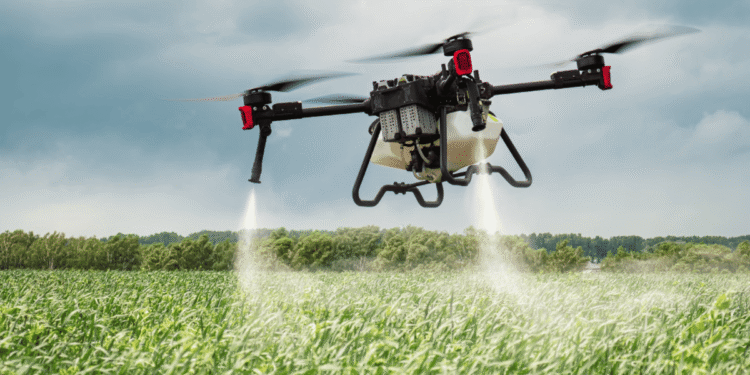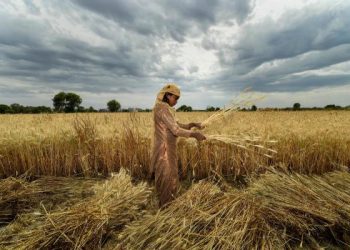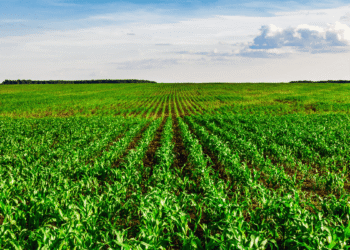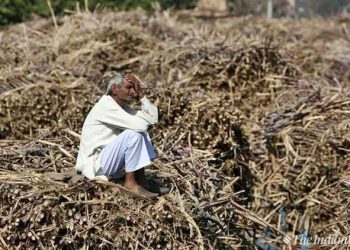Drones are revolutionizing the way farmers manage their crops and livestock. By providing farmers with an aerial view of their land, drones are helping to increase crop yields, monitor livestock, and improve the overall efficiency of farming operations.
Through the use of infrared technology and other advanced sensors, drones can detect the health of crops, the presence of weeds, and even the location of livestock. By quickly and accurately providing farmers with data, drones are allowing them to make more informed decisions about how to best manage their farms.
Overview of drone technology
A drone is an unmanned aircraft that can be controlled remotely. Drones come in a variety of shapes, sizes, and designs, and can be used for many different applications, such as military operations, emergency response, commercial activities, and more.
One of the main advantages of drones is that they can be used in places where it would be too dangerous or difficult to use conventional aircraft, such as in disaster relief efforts, during search and rescue operations, and in agriculture.
Drones are gaining traction in the agriculture industry as a more efficient, cost-effective alternative to more traditional methods of crop monitoring. Rather than having to rely on visual inspections and manual data collection, drones can be programmed to fly over fields and collect data about the health of crops and the presence of weeds.
Drones can also help farmers collect data about soil conditions, and nutrient levels, and provide them with insight into the overall health of livestock. With drones, farmers can collect data more quickly, more accurately, and while using fewer resources compared to other methods of crop monitoring.
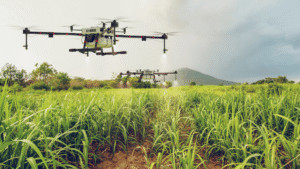
Benefits of drones in farming
As drones provide farmers with a more in-depth overview of their farms, they can help growers more efficiently and effectively manage operations. What’s more, the use of drones in farming also has many added benefits for the environment. By reducing the need for ground-based inspections, drones can decrease fuel consumption and cut back on carbon emissions.
Additionally, drones can help farmers reduce their usage of water by providing them with data that can be used to optimize irrigation. By collecting data at a greater scale and frequency than ever before, drones can allow farmers to make more informed decisions about their plans for the crops and livestock on their farms.
This allows growers to optimize their operations and produce high-quality crops in an environmentally-friendly way. As the adoption of drone technology continues to grow, farmers will have a new tool at their disposal that can help them maximize efficiency, minimize waste, and maximize crop yields.
Different types of drones used in farming
Different types of drones are used for different applications in agriculture.
Some common types of drones used for farming include:
- Fixed-wing drones: These drones have wings that stay level and straight when they’re in flight. Fixed-wing drones are more stable in the air and are able to cover longer distances than other types of drones. Fixed-wing drones are used for crop monitoring and are typically larger and more expensive than other types of drones.
- Tilting-rotor drones: These drones are similar to helicopters in that they have rotors that can swivel to change direction during a flight. Tilting-rotor drones are effective at covering shorter distances than fixed-wing drones and are typically more affordable.
- VTOL drones: These drones are similar to tilt-rotor drones in that they have rotors that can swivel to change direction during a flight. VTOL drones are more sophisticated than tilt-rotor drones; they’re able to hover in one place, unlike tilt-rotor drones, which must always be in motion.
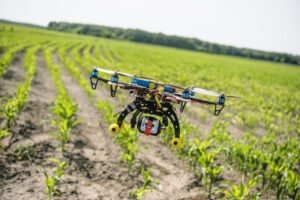
Uses of drones in farming
- Crop monitoring: Drones can be used to monitor crops for signs of diseases or pests, such as insects or rodents. Drones are also able to detect symptoms of plant diseases that can’t be seen from the ground. This allows farmers to make better decisions about how to best respond to a threat.
- Weed detection: Drones can be used to detect the presence of weeds in crops. By using infrared cameras and other sensors, drones can identify weeds before they’re able to affect a crop.
- Soil analysis: Drones can be used to analyze the soil and determine nutrient levels. By collecting data at a higher frequency, drones can help farmers better manage the nutrients in their soil and optimize crop yield.
The applications of drones in farming
- Agriculture: Drones can be used to monitor crops, collect data about soil conditions, and detect weeds in fields.
- Herd management: Drones can be used to track livestock and detect animal health issues.
- Weather forecasting: Drones can be used to collect data about weather conditions, such as humidity, temperature, rainfall, and wind speed.
- Farming analytics: Drones can be used to collect data about various farming operations and processes, such as irrigation levels and soil nutrients.
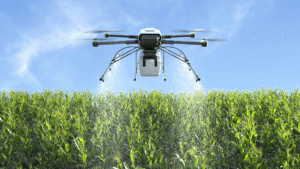
The advantages of using drones in farming
Drones can provide farmers with a more comprehensive view of their land, allowing them to detect new threats and optimize operations more quickly. Drones are also able to collect data at a much larger scale than other monitoring methods, allowing them to provide farmers with a more detailed analysis of their farms.
Additionally, drones are able to collect data at a greater frequency than other methods, which can allow farmers to identify changes in conditions more quickly and respond more effectively. These advantages can help farmers achieve better crop yields and create a more efficient and sustainable farming operation.
The challenges of using drones in farming
One of the biggest challenges associated with using drones in agriculture is collecting accurate data. Drones are programmed to fly over fields and collect data about the health of crops and the presence of weeds, but they’re unable to distinguish between different types of weeds.
This means that a single weed in a field will show up as multiple weeds on a drone’s sensors. Drones are also unable to detect the size of the weed, so a small weed may appear to be the same size as a large weed. To ensure accurate data, farmers should implement a weed management plan, which outlines the best way to remove weeds from the fields.
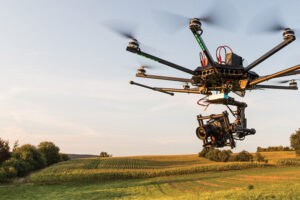
How drones are making farming more sustainable
Drones are allowing farmers to more effectively manage weeds and pests in their fields, which is helping to make agriculture more sustainable. By more effectively managing weeds, growers can avoid the use of herbicides and pesticides, which can have a negative impact on the environment. Additionally, by reducing the need for pesticides and herbicides, farmers can help protect water and soil from pollution.
When pesticides or herbicides seep into the soil or come into contact with water, they can inhibit plant growth, harm wildlife, and pollute the environment. Thanks to drones, farmers are able to manage weeds and pests in a sustainable way. This can help to ensure that agriculture is able to meet the growing demand for food for the world’s population for years to come.
The future of drones in farming
As technology advances, drones are likely to continue to evolve and be used in more and more ways. In the future, drones may be able to collect data about the health of crops, soil conditions, and the presence of pests and diseases.
Additionally, drones are likely to become more advanced, allowing them to collect data more quickly and efficiently than they do now. As drones continue to grow in popularity, the technology is likely to become more available and accessible to farmers. More farmers may begin to use drones to track and manage their fields, which could lead to even better crop yields and a more efficient farming operation.
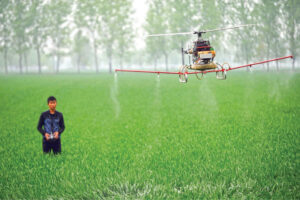
How to get started with drone farming
If you’re interested in using drones to improve your farming operations, there are a couple of things you can do to get started. First, you’ll need to determine what type of drone would be best for your operations. Drones come in many different shapes and sizes, which means that there’s one available for almost every application.
Once you’ve chosen a drone, you’ll need to find a way to fund your operations. While basic drones are less expensive than helicopters, they’re still a significant investment. You may want to consider applying for funding from a company, like AgWired, or a government program that can help you get your operations off the ground.

